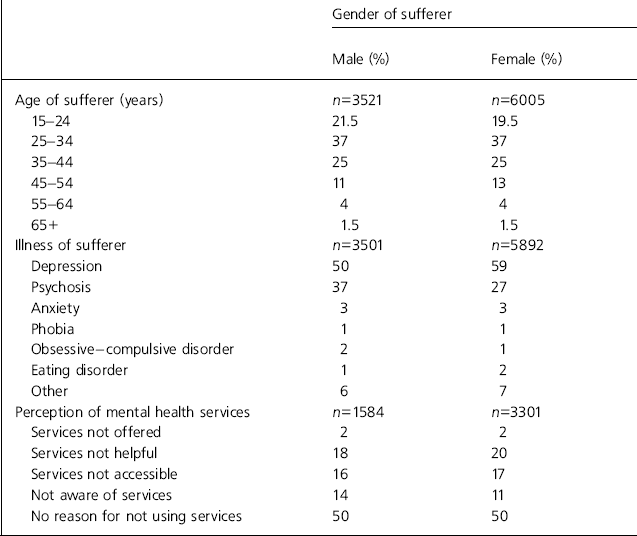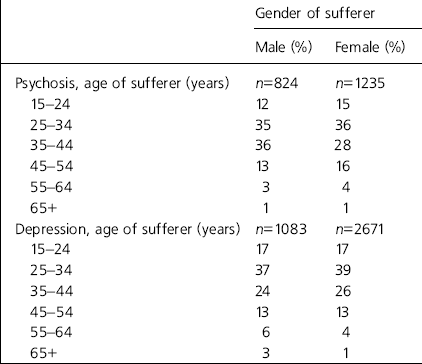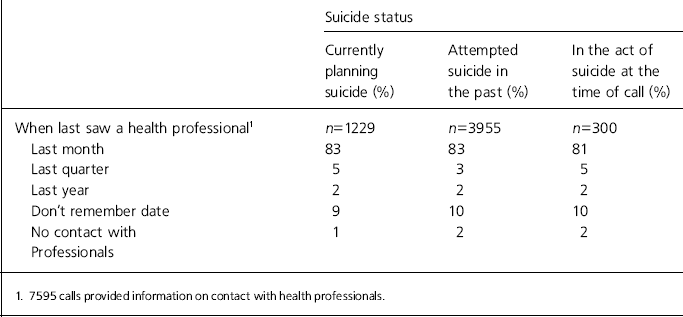In 1992, the UK Department of Health published its strategy to monitor progress towards the achievement of health targets specified in the Health of the Nation White Paper (Department of Health, 1992a ). These targets included, among others, the reduction by the year 2000 of the overall incidence of suicide rate by at least 15% and the suicide rate of severely mentally ill people by at least 33% (Department of Health, 1992b ). In the 1999 Saving Lives: Our Healthier Nation paper, the government set a new target which is the reduction of the rate from suicide and undetermined injury by at least a fifth by 2010 — saving up to 4000 lives in total (Department of Health, 1999).
Statistics published by the Office of Population Censuses and Surveys in England and Wales (OPCS) showed that, in 1996, there were 3455 registered deaths due to suicide (ICD-9 E950-959 (World Health Organization, 1978)), and that since 1993, there has been an overall decrease in deaths due to suicide (OPCS, 1997). This has, however, been accompanied by an increase in suicide rates among young men (15-44 years of age) (OPCS, 1997). Men outnumber women in committing suicide by a ratio of three to one. This has been the case since 1989.
Although the literature on the epidemiology of suicide is extensive, little information is available on the profile and needs of people who suffer from a psychiatric disorder and who have suicidal intentions.
The study
SANELINE
SANELINE was established by the mental health charity SANE in 1992. It is a national out of hours telephone helpline for sufferers of mental illness, their families/carers and for mental health professionals. SANELINE provides one to one telephone support, and information on treatments and therapies, mental health laws, health and social services and on voluntary groups. Calls are answered by trained volunteers who record the information provided by callers on ‘Call Report Sheets’ (CRSs). The CRS is a confidential form which covers the demographic characteristics of callers (age and gender), reason for calling SANELINE, and any information on diagnosis, symptoms and medication and on the use of and satisfaction with mental health services.
Sample
Analyses were conducted on 10 359 calls made between January 1996 and June 1998. This corresponded to 15% of all calls logged on SANELINE database for that period of time. To be included in the sample, sufferers must have reported having or having had suicidal intention, and carer or professional callers must also have said that the sufferers were suicidal.
In total, 75% of callers in the sample were sufferers (n=7804), 22% of carers (n=2226) and 3% of professionals (n=329) calling on behalf of sufferers. Volunteers spent 4143 hours in contact with these callers. The average length of call was 24 minutes, compared with 16 minutes, for non-suicidal callers.
Because information is entirely volunteered by callers, missing information on most of the areas covered in the CRS is expected. Therefore, missing cases were removed from the analysis on each variable, accounting for the reduction in the total number of cases in each individual analysis.
Findings
Gender and age
Sixty-three per cent (n=6490) of calls related to females. Females made up 68% of suicidal caller groups and 78% of carer callers. As far as age distribution is concerned, the most common age group for suicidal callers, regardless of gender, was between 25-34 years, which is in congruence with national statistics (see Table 1).
Table 1 Gender of sufferer by age, illness and perceptions of mental health services

| Gender of sufferer | |||
|---|---|---|---|
| Male (%) | Female (%) | ||
| Age of sufferer (years) | n = 3521 | n = 6005 | |
| 15-24 | 21.5 | 19.5 | |
| 25-34 | 37 | 37 | |
| 35-44 | 25 | 25 | |
| 45-54 | 11 | 13 | |
| 55-64 | 4 | 4 | |
| 65+ | 1.5 | 1.5 | |
| Illness of sufferer | n = 3501 | n = 5892 | |
| Depression | 50 | 59 | |
| Psychosis | 37 | 27 | |
| Anxiety | 3 | 3 | |
| Phobia | 1 | 1 | |
| Obsessive-compulsive disorder | 2 | 1 | |
| Eating disorder | 1 | 2 | |
| Other | 6 | 7 | |
| Perception of mental health services | n = 1584 | n = 3301 | |
| Services not offered | 2 | 2 | |
| Services not helpful | 18 | 20 | |
| Services not accessible | 16 | 17 | |
| Not aware of services | 14 | 11 | |
| No reason for not using services | 50 | 50 | |
Reason for calling the helpline
Sixty-two per cent (n=6395) called the helpline because they wanted support, 21% (n=2251) because they felt distressed, and 17% (n=1713) because they wanted information. The type of information required related to: the availability of social support groups in local area of residence (49%, n=833); inquiries about legal matters (18%, n=308); general information on illness (17%, n=293); and medication (12%, n=200). Other inquiries made up 4% of the calls.
Illness
Fifty-five per cent (n=5227) of all calls, where information on illness was provided, related to people with depression and 31% (n=2876) to people with psychosis. The rest (13%, n=604) related to other illnesses (phobias, compulsive—obsessive disorder, eating disorders, anxiety, etc.). The distribution by gender showed that for psychosis, more calls related to males than females, whereas for depression, more calls related to females than males (see Table 1). For both illnesses, however, there were no major differences by gender in age of callers with suicidal ideation, though the lowest proportion of calls pertained to male callers with psychosis in the 15-24 age group (Table 2).
Table 2 Gender by age of sufferer callers and type of illness

| Gender of sufferer | |||
|---|---|---|---|
| Male (%) | Female (%) | ||
| Psychosis, age of sufferer (years) | n = 824 | n = 1235 | |
| 15-24 | 12 | 15 | |
| 25-34 | 35 | 36 | |
| 35-44 | 36 | 28 | |
| 45-54 | 13 | 16 | |
| 55-64 | 3 | 4 | |
| 65+ | 1 | 1 | |
| Depression, age of sufferer (years) | n = 1083 | n = 2671 | |
| 15-24 | 17 | 17 | |
| 25-34 | 37 | 39 | |
| 35-44 | 24 | 26 | |
| 45-54 | 13 | 13 | |
| 55-64 | 6 | 4 | |
| 65+ | 3 | 1 | |
As far as comorbidity is concerned, alcohol addiction was reported in 336 (3%), while street drug dependency was mentioned in 119 calls (1%). Dependency on both was reported in 32 calls (0.3%).
Treatment
Ninety per cent of callers with suicidal ideation (n=6651) were on prescribed medication; 22% (n=1626) had hospitalisation episodes, and 18% (n=1330) had counselling/therapy. Electroconvulsive therapy was reported in 173 calls. No mention of any type of treatment was made in 2969 calls (29% of sample). It is to be noted that this distribution was not different to that of callers with no suicidal ideation.
Suicide status and use of services
Half of all callers (n=3015) gave no reasons why they contacted SANELINE. A fifth (n=1204) said they were not aware of the availability of services in their area of residence. Another fifth (n=1213) said they used the services and found them not helpful, and 14% (n=936) said that they could not access the services when they needed them (at weekends, out of office hours, etc.). Two per cent (n=132) said that no services were offered to them. There were no major differences by gender in suicidal callers' perceptions of services; however, males were less likely than females to be aware of the availability of services; the 3% difference was the largest between the two groups (Table 1).
Half of the callers with suicidal ideation (n=5234) had attempted suicide in the past, almost a fifth (n=1619) were planning to commit suicide at the time of the call, and 5% (n=475) were in the act of suicide when calling the helpline. Most of those who were planning to commit suicide, or were in the act of committing suicide when they called the helpline, were in contact with services, that is, had seen a health professional (doctor or nurse) in the last month. This was also true of those who attempted suicide in the past (Table 3).
Table 3 Sufferer suicide status by use of services

| Suicide status | ||||||
|---|---|---|---|---|---|---|
| Currently planning suicide (%) | Attempted suicide in the past (%) | In the act of suicide at the time of call (%) | ||||
| When last saw a health professional1 | n = 1229 | n = 3955 | n = 300 | |||
| Last month | 83 | 83 | 81 | |||
| Last quarter | 5 | 3 | 5 | |||
| Last year | 2 | 2 | 2 | |||
| Don't remember date | 9 | 10 | 10 | |||
| No contact with Professionals | 1 | 2 | 2 | |||
| 1. 7595 calls provided information on contact with health professionals. | ||||||
Caller's story
Qualitative information about the callers was recorded on the back of the CRSs. This information, when provided, gave insights on the problems that callers were facing. Social issues and issues related to care and services were often mentioned by callers. For example, some callers were not content with the treatment or care they received. Some callers specifically criticised their health providers. Some reported social problems such as stigma, social network, social isolation and problems related to daily living. Examples of cases are found in the Appendix.
Comment
This study is an audit of calls to SANELINE, a national mental health helpline. Its conclusions therefore depend on the accuracy of the data provided by callers. The sample may be biased, and callers may not be representative of people with mental health problems in the general population. However, this bias may give this group of sufferers a particular importance. They are often sufferers for whom mental health services were unhelpful or unavailable, or whose social and/or personal conditions prevented them from confronting their illness, and thus suffered in silence.
The data from this audit showed that the majority of sufferers in our sample were receiving care. A large proportion of them saw a health professional in the month preceding their SANELINE call. This is in line with a recent national clinical survey which reported that 24% of people who committed suicide had had contact with mental health services in the year before death (Reference Appleby, Shaw and AmosAppleby et al, 1999). These findings cast doubt on the effectiveness of the current system of care that may be failing to meet the health and social needs of its most vulnerable users. A considerable proportion of callers also reported problems relating to access to and availability of services when needed, thus emphasising the importance of identifying ways to mobilise effectively and efficiently existing National Health Service resources, and to improve awareness of and faster access to services.
The audit also showed that females were more likely to seek help than males. Females with suicidal ideation were at least twice as likely as males to call the helpline, and female carers were almost four times more likely to seek help on behalf of the person with suicidal ideation than their male counterparts. This may partly explain why more males than females eventually go ahead with the act of suicide. This gender difference could have serious implications on use of services and outcome of illness. Our analysis showed that males with suicidal ideation were less likely to be aware of the availability of services that could provide them with help. It would therefore seem that as yet strategies to increase male awareness of the need to seek help when feeling suicidal, and their awareness of the existing sources of help, have failed. Given that males are in general less easy to engage in mental health treatment (Reference Hawton, Fagg and SimkinHawton, 1997), innovative methods of targeting them are needed if we are to reduce the prevalence of suicide among this group. Another group that could be targeted is those under 25 years of age, a group less likely to call the helpline, and whose sources of help and support are unclear. It is advisable, however, for developers of any strategy targeting this group to take into account the current youth culture and to conduct interventions through a medium relevant to that culture.
Appendix
Case 1
Ms J. suffers from a personality disorder. She saw her social worker today and was very upset by the visit. Ms J. wanted her medication to be changed, as she wanted to have children. However, she was told by her social worker that she was not fit to be a mother. This left her very distressed. She said she has no one to turn to.
Case 2
Mr T. has been suffering from severe depression for several years now. He does not feel he wants to go on living. He said that hospital care was of no help to him in the past. He called his community psychiatric nurse (CPN) tonight and told him that he wanted to kill himself. He said that the CPN told him that he had no time for a deep and meaningful conversation and hung up. Mr T. felt very desperate and let down.
Case 3
Ms M. has been suffering from depression continuously for four-and-a-half years now. She wanted to know whether people overcome this problem. She feels she cannot open up to her husband for fear of losing him. She would like to have hospital care but she is afraid of losing her dignity and of losing her husband and friends.
Case 4
The caller is very concerned about her friend M. who suffers from schizophrenia. He has been ill for 10 years now, and has been sectioned a few times. Last month he took an overdose. The caller said she is aware that M. lacks social and communication skills and this is making him worse because it prevents him from seeking help. She said she needed help on what to do.
Acknowledgements
I thank Marjorie Wallace (Chief Executive of SANE), Helen Hyslop, Tom Margerison and Donna Wright for their feedback on drafts of the paper.






eLetters
No eLetters have been published for this article.